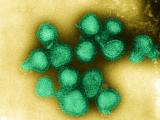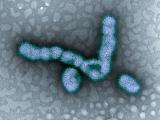Oct 13, 2009 (CIDRAP News) – About half of the pandemic H1N1 vaccine coming from manufacturers is now injectable doses, and shipments are on their way to states to use this week alongside the nasal-spray version that is already available, the US Centers for Disease Control and Prevention (CDC) said today.
The arrival of the injectable vaccine in doctors' offices and public health clinics will improve efforts to target high-risk groups such as the youngest children and youth, pregnant women, and people with chronic health conditions. The first shipments of pandemic vaccine that went to states last week were the live attenuated intranasal form of the vaccine, made by MedImmune, which is recommended only for healthy people aged 2 through 49 years.
Anne Schuchat, MD, director of the CDC's National Center for Immunization and Respiratory Diseases, told reporters at a press briefing today that as of yesterday 9.8 million vaccine doses were available to states, which have placed orders for 5.8 million doses. The production total since Oct 8 has risen by 3 million doses, and state orders have increased by 2.1 million doses.
The CDC also said today that preliminary data from the largest report so far of pandemic flu hospitalizations in the United States shows that serious infections still primarily involve patients who have underlying medical conditions. The data on about 1,400 adults and more than 500 children are from the CDC's Emerging Infection Program Network, an active surveillance system that includes flu hospitalization data from 10 states.
Schuchat said there were no surprises in the data, which confirm earlier findings from 272 hospitalized patients that indicated that pregnant women, children, and people with underlying medical conditions have the highest risk. "The larger numbers make us feel more confident about the people in the risk groups to be vaccinated," she said.
Among the adults in the group, 88 (6%) were pregnant women, she said. Also, 26% of the adults had asthma, 10% had diabetes, 8% had other chronic lung conditions, and 7.6% had immune system compromise.
The new findings suggest about 45% adults who have been hospitalized with pandemic H1N1 infections didn't have an underlying condition that put them in one of the risk groups, Schuchat reported. That compares with 27% who had no reported underlying condition in last week's report on 272 patients who were hospitalized in the spring wave of H1N1. Schuchat said the CDC is still looking into what role obesity may be playing in the more severe cases.
In children, the most common underlying conditions were asthma, other chronic lung conditions, and neuromuscular diseases, she said. She added that about 5.8% of children had hemoglobinopathies such as sickle cell anemia and that the CDC needs to review the pediatric findings more closely.
The CDC has received reports of five more pediatric flu deaths since its last update on Oct 9, Schuchat told reporters. That brings the total to 81.
In other developments, Schuchat acknowledged delays in distribution of the seasonal flu vaccine. However, she said health officials are seeing very little circulation of seasonal flu viruses. "Even if more vaccine isn't available until November or December, we think it will be just fine to be vaccinated then," she said.
See also:
Oct 8 CIDRAP News story "Two reports offer new data on severe H1N1 cases"



















